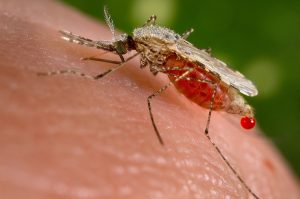
Anopheles stephensi mosquito which carries the new malaria parasite commonly found in urban areas has been cited in Saku and Laisamis areas of Upper Eastern
Meru, Isiolo, Samburu, Marsabit, and Tharaka Nithi in alarm as MoH report cases
By Eastern Newspaper Team
Health experts have raised alarm over the dangerous new malaria-causing mosquito which likes to live in cities or highly populated areas discovered in the Upper Eastern region.
The mosquito, scientifically identified as Anopheles stephensi, a deadlier species, breeds all year round in highly populated, urban areas, has been reported in Laisamis and Saku sub-counties of Marsabit County and has the potential to increase malaria incidences by more than 50 percent.
Other areas exposed to this deadly parasite include Samburu, Isiolo Meru, and the adjacent areas.
The mosquito is known to transmit both Plasmodium falciparum and Plasmodium Vivax. Anopheles stephensi was also found in many African countries including Nigeria, Ethiopia, Somalia, Sudan, and Djibouti and it prefers urban areas.
To the findings, malaria transmission in northern Kenya is likely to increase, causing a significant threat to the control and elimination of the disease in the country.
This vector differs from other malaria vectors due to its ability to develop in man-made containers, preferably in clean water. Still, also in contaminated water, poor garbage disposal points, man-made water tanks, poorly discarded plastic containers, wells, and fresh pools of water, this is according to research published in Research Squire Journal recently.
The Anopheles stephensi transmits malaria throughout the year making it hard to fight, control and completely eliminate Malaria contrary to other mosquito species in Africa whose populations keep on rising and falling with the rainy seasons.
World Health Organization said in a statement says that if nothing is done, the species will put more than 126 million people in 44 cities at risk of malaria.
Marsabit County Executive for Health Grace Garmo said medics were worried over to sudden increase of Malaria cases in the County adding that the ministry was in the darkness on how to treat and eliminate the vector.
They are waiting for support from the Kenya Medical Research Institute (KEMRI) after it concludes the ongoing research on the behavior and breeding of the mosquito.
“We invited KEMRI for follow-up research so that we will be able and prepared on treatment and elimination of the new species. We all have scanty information on how it breeds, and how it rests and we urge people to sleep under treated mosquito nets till the research is concluded to know the type of reagents to apply in response to treatment and protocols to be used,” Garmo said.
KEMRI had earlier noted that Anopheles Stephensi had been a concern in North Asia and the Middle East.
According to the World Health Organization, the species is said to be resistant to several classes of insecticides traditionally used to treat bed nets and home environments, has the propensity to bite both indoors and outdoors, and feeds on both animal and human blood.
The WHO recently called for heightened surveillance and the development of response strategies to limit the spread of the vector.
This report highlights five key areas of focus: increased collaboration across sectors and borders; strengthening surveillance; improving information exchange; developing national guidelines; and, prioritizing research to evaluate tools against this vector.
Dr. Jan Kolaczinski, who leads the Vector Control and Insecticide Resistance unit with the WHO Global Malaria Programme said “We are still learning about the presence of Anopheles stephensi and its role in malaria transmission in Africa.”
The county government of Meru’s health department has cautioned residents against the disease as it heightened surveillance to control its spread.
“The department of health wishes to alert residents about the recent detection of a new Malaria Vector, Anopheles Stephensi in Kenya. This species of Mosquito is dangerous and can cause the spread of Malaria in both urban and rural settings. We urge all residents especially Women and children to protect selves from Mosquito bites by using treated nets, and repellents and wearing long-sleeved clothing,” the department headed by CECM M’Ethingia Mutuma read in part.
The department called on the public to report suspected Malaria cases to the nearest health facility for prompt diagnosis and treatment.
In 2020, nearly half of the World’s population was at risk of Malaria. The WHO African Region was home to 95% and 96% of Malaria cases and deaths respectively.
There were an estimated 247 million cases of Malaria in 2021 while Malaria deaths were estimated to be 619, 000.
The WHO Global Vector Control Response 2017-2030 provides a framework for investigating and implementing national responses to Anopheles stephensi should be integrated with efforts for other vector-borne diseases such as Dengue Fever, Yellow Fever, and Chikungunya.
Malaria is a life-threatening disease that is treatable and curable and is transmitted to people through bites of infected female Anopheles mosquitos.
5 parasite species cause Malaria in humans.




